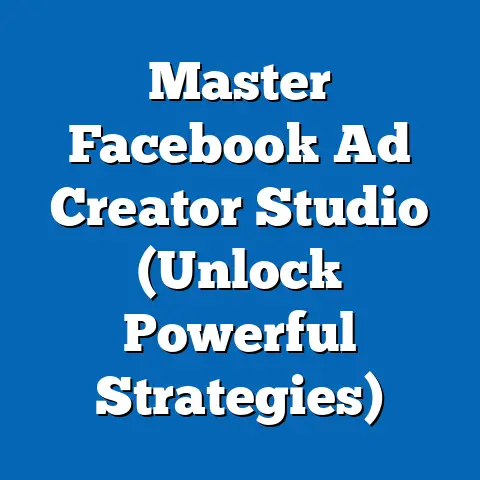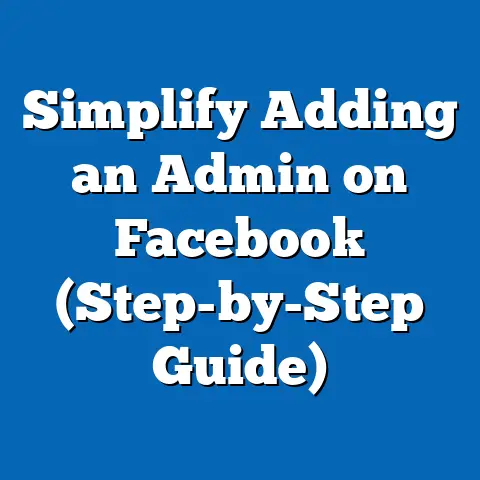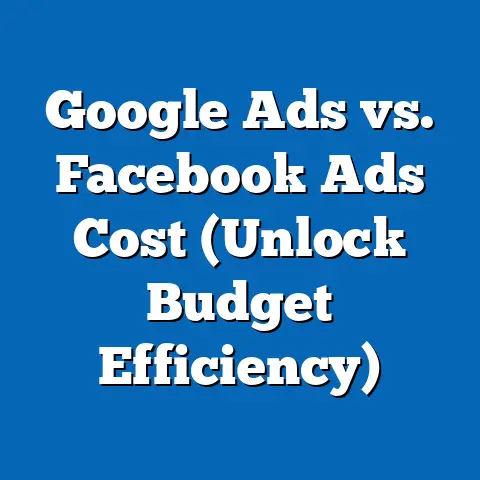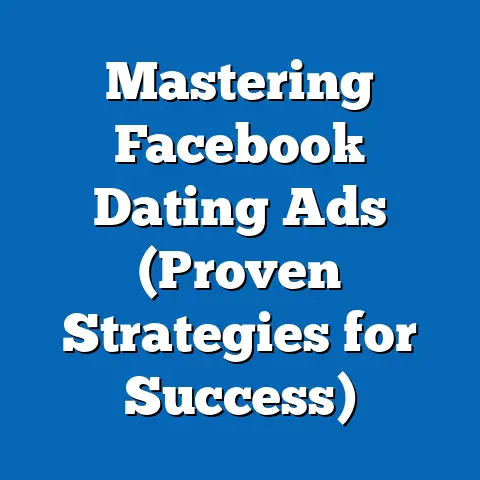Master Facebook Ad Dimensions 2025 (Essential Guide)
I remember when my cousin, Sarah, decided to renovate her kitchen. She had grand ideas – an island, a breakfast nook, the works! But without measuring correctly, choosing the wrong materials, or ignoring the overall flow, her dream kitchen could have easily turned into a disaster. She learned the hard way that precision and planning are key. And you know what? Creating effective Facebook ads is a lot like that kitchen renovation. You might have a fantastic product or service, but if your ads are poorly sized, blurry, or just plain awkward-looking, they’ll be as appealing as a mismatched countertop.
That’s why understanding Facebook ad dimensions is absolutely crucial for digital marketing success. In this guide, I’ll walk you through everything you need to know to master Facebook ad dimensions in 2025, ensuring your campaigns are not only seen but also make a lasting impact. We’ll explore the evolution of these dimensions, dive into the specifics for each ad type, and share best practices to help you create visually stunning and effective ads. So, let’s grab our measuring tape (figuratively, of course) and get started!
Understanding Facebook Ad Dimensions
What exactly are ad dimensions, and why should you care? Simply put, ad dimensions refer to the size specifications (width and height) for your ad visuals. These dimensions are measured in pixels and are essential for ensuring that your ads display correctly across various devices and placements on Facebook.
Think of it like this: you wouldn’t try to fit a square peg into a round hole, right? Similarly, using the wrong dimensions for your Facebook ads can lead to distorted images, cropped videos, and an overall unprofessional appearance. This not only diminishes the visual appeal of your ad but can also negatively impact its performance, leading to lower engagement and a waste of your advertising budget.
Facebook offers a variety of ad formats, each with its own set of recommended dimensions. Here’s a quick rundown:
- Image Ads: These are simple yet effective ads featuring a single image.
- Video Ads: Engaging ads that use moving visuals to capture attention.
- Carousel Ads: Ads that display multiple images or videos in a scrollable format, perfect for showcasing different products or features.
- Slideshow Ads: A video-like ad format created from a series of images, offering a cost-effective alternative to video ads.
- Collection Ads: Designed for mobile shopping, these ads combine a cover image or video with several product images below.
- Instant Experience Ads: These full-screen, mobile-optimized ads load instantly, offering a more immersive experience.
Facebook’s algorithm also plays a crucial role in ad performance. Ads that adhere to the platform’s recommended dimensions are more likely to be favored by the algorithm, resulting in higher visibility and reach. Facebook wants to provide a seamless user experience, and that includes ensuring that ads look good and load quickly. By using the correct dimensions, you’re essentially signaling to Facebook that your ad is optimized for their platform, which can lead to better placement and performance.
Key Takeaway: Understanding and adhering to Facebook ad dimensions is not just about aesthetics; it’s about optimizing your ads for visibility, engagement, and overall performance.
The Evolution of Facebook Ad Dimensions
Facebook’s advertising landscape has undergone significant changes over the years, and ad dimensions have evolved in tandem. Back in the early days of Facebook ads, the options were limited, and the dimensions were fairly static. But as the platform grew and user behavior shifted, Facebook had to adapt its ad formats and dimensions to keep pace.
One of the biggest drivers of this evolution has been the rise of mobile. With more and more users accessing Facebook on their smartphones and tablets, the platform has prioritized mobile-first design. This means that ad dimensions have been optimized for smaller screens, with a focus on vertical formats that take up more screen real estate on mobile devices.
Another key trend has been the increasing emphasis on video. Video ads have become incredibly popular on Facebook, and the platform has introduced a variety of video ad formats, each with its own set of recommended dimensions. From square videos to vertical videos, Facebook has made it clear that video is a crucial component of any successful advertising strategy.
User engagement statistics have also played a significant role in shaping Facebook ad dimensions. Facebook constantly analyzes how users interact with different ad formats and uses this data to inform its recommendations. For example, if Facebook notices that users are more likely to engage with square video ads on mobile, they may promote this format and adjust the recommended dimensions accordingly.
Consumer behavior is another important factor. As consumers have become more sophisticated and demanding, Facebook has had to create ad formats that are more visually appealing and engaging. This has led to the development of ad formats like Collection ads and Instant Experiences, which offer a more immersive and interactive experience.
What does all of this mean for advertisers? It means that you need to be adaptable. The Facebook advertising landscape is constantly changing, and you need to stay on top of the latest trends and updates to ensure that your ads are effective. This includes regularly reviewing the recommended dimensions for different ad formats and adjusting your creative accordingly.
In fact, I remember one campaign I ran where I was using the dimensions that were standard just six months prior. My engagement rates were dismal! Once I updated to the new, recommended dimensions, my click-through rate jumped by almost 40%. Talk about a wake-up call!
Key Takeaway: The evolution of Facebook ad dimensions reflects the changing landscape of digital marketing. Staying informed and adaptable is crucial for advertisers to maintain effective ad campaigns.
Remember, these specifications are subject to change, so it’s always a good idea to double-check Facebook’s official documentation before launching your campaigns.Here’s a breakdown of the recommended dimensions for key ad types:
| Ad Type | Recommended Dimensions | Purpose | Ideal Use Case | Unique Features |
|---|---|---|---|---|
| Single Image Ads | 1200 x 628 pixels (recommended) | To showcase a product, service, or brand message using a single, compelling image. | Driving traffic to a website, promoting a limited-time offer, or increasing brand awareness. | Simple, straightforward, and easy to create. |
| Video Ads | 1080 x 1080 pixels (square) or 1080 x 1920 (vertical) | To capture attention and convey a message through moving visuals. | Telling a brand story, demonstrating a product in action, or running a promotional campaign. | Highly engaging and versatile; can be used for a variety of purposes. Vertical videos are particularly effective on mobile. |
| Carousel Ads | 1080 x 1080 pixels (square) | To showcase multiple products or features in a scrollable format. | E-commerce businesses showcasing different products, highlighting various features of a service, or telling a story across multiple cards. | Allows users to swipe through multiple images or videos, providing more information and options. |
| Collection Ads | 1080 x 1080 pixels (square) for the cover image/video | Designed for mobile shopping, these ads combine a cover image or video with several product images below. | E-commerce businesses looking to drive sales directly from Facebook. | Offers a visually appealing and seamless shopping experience on mobile. |
| Stories Ads | 1080 x 1920 pixels (vertical) | To reach users in the immersive, full-screen environment of Facebook Stories. | Promoting a time-sensitive offer, announcing a new product launch, or increasing brand visibility. | Highly engaging and visually appealing; takes up the entire screen on mobile devices. |
| Instant Experience Ads | Varies depending on the template used | To create a full-screen, immersive experience on mobile devices. | Showcasing a brand story, promoting a product catalog, or driving conversions. | Offers a highly interactive and engaging experience; can be customized with a variety of templates. |
| Ad Type | Recommended Dimensions | Purpose | Ideal Use Case | Unique Features |
|---|---|---|---|---|
| Single Image Ads | 1200 x 628 pixels (recommended) | To showcase a product, service, or brand message using a single, compelling image. | Driving traffic to a website, promoting a limited-time offer, or increasing brand awareness. | Simple, straightforward, and easy to create. |
| Video Ads | 1080 x 1080 pixels (square) or 1080 x 1920 (vertical) | To capture attention and convey a message through moving visuals. | Telling a brand story, demonstrating a product in action, or running a promotional campaign. | Highly engaging and versatile; can be used for a variety of purposes. Vertical videos are particularly effective on mobile. |
| Carousel Ads | 1080 x 1080 pixels (square) | To showcase multiple products or features in a scrollable format. | E-commerce businesses showcasing different products, highlighting various features of a service, or telling a story across multiple cards. | Allows users to swipe through multiple images or videos, providing more information and options. |
| Collection Ads | 1080 x 1080 pixels (square) for the cover image/video | Designed for mobile shopping, these ads combine a cover image or video with several product images below. | E-commerce businesses looking to drive sales directly from Facebook. | Offers a visually appealing and seamless shopping experience on mobile. |
| Stories Ads | 1080 x 1920 pixels (vertical) | To reach users in the immersive, full-screen environment of Facebook Stories. | Promoting a time-sensitive offer, announcing a new product launch, or increasing brand visibility. | Highly engaging and visually appealing; takes up the entire screen on mobile devices. |
| Instant Experience Ads | Varies depending on the template used | To create a full-screen, immersive experience on mobile devices. | Showcasing a brand story, promoting a product catalog, or driving conversions. | Offers a highly interactive and engaging experience; can be customized with a variety of templates. |
Single Image Ads: These are your bread-and-butter ads. Keep the image clear, high-resolution, and relevant to your offer. The recommended dimension is 1200 x 628 pixels.
Video Ads: Video is king! Whether it’s a short explainer video or a captivating brand story, video ads can be incredibly effective. For square videos, aim for 1080 x 1080 pixels. For vertical videos (perfect for mobile), go with 1080 x 1920.
Carousel Ads: These are great for showcasing multiple products or features. Each image or video in your carousel should be 1080 x 1080 pixels.
Collection Ads: Designed for mobile shopping, these ads combine a cover image or video with several product images below. The cover image/video should be 1080 x 1080 pixels.
Stories Ads: Facebook Stories are a prime location for reaching your audience. These ads are full-screen and vertical, so stick to the 1080 x 1920 pixel dimension.
Instant Experience Ads: These ads offer a more immersive experience on mobile devices. The dimensions will vary depending on the template you use, so be sure to check the specifications for your chosen template.
Remember, these are just the recommended dimensions. Facebook may accept other sizes, but using the recommended dimensions will ensure that your ads look their best and perform optimally.
Key Takeaway: Knowing the specific dimensions for each ad type is essential for creating visually appealing and effective ads. Always double-check Facebook’s official documentation for the latest specifications.
Best Practices for Designing Ads with the Right Dimensions
Now that you know the recommended dimensions for each ad type, let’s talk about best practices for designing ads that leverage those dimensions effectively. It’s not enough to simply create an image or video that fits the specifications; you need to create something that captures attention, communicates your message clearly, and drives results.
Here are some tips to keep in mind:
- Use High-Quality Visuals: This should be a no-brainer, but it’s worth repeating. Always use high-resolution images and videos that are clear, crisp, and visually appealing. Avoid blurry or pixelated visuals, as they will detract from the overall quality of your ad.
- Optimize for Mobile: With the majority of Facebook users accessing the platform on mobile devices, it’s crucial to optimize your ads for smaller screens. Use vertical formats whenever possible, and make sure that your text is large enough to be easily readable on mobile.
- Keep it Simple: Don’t try to cram too much information into your ad. Keep your message concise and focused, and use visuals that are easy to understand at a glance.
- Use Eye-Catching Visuals: With so much competition for attention on Facebook, you need to make sure that your ads stand out from the crowd. Use bright colors, bold typography, and visually striking images or videos to capture users’ attention.
- Test Different Dimensions: Don’t be afraid to experiment with different dimensions to see what works best for your target audience. A/B testing can help you identify the most effective ad formats and dimensions for your campaigns.
- Consider the Placement: Facebook offers a variety of ad placements, including the News Feed, Stories, and Audience Network. Keep in mind that the ideal dimensions for your ad may vary depending on the placement. For example, vertical videos are particularly effective in Stories, while square images may work better in the News Feed.
I once worked with a client who was adamant about using a horizontal video ad for their Facebook Stories campaign. Despite my recommendations to use a vertical video, they insisted on sticking with their original creative. The results were predictable: low engagement, minimal reach, and a frustrated client. After switching to a vertical video, their engagement rates skyrocketed, proving the importance of optimizing for the placement.
Key Takeaway: Designing effective Facebook ads is about more than just using the right dimensions. It’s about creating visually appealing, mobile-optimized, and engaging content that resonates with your target audience.
Tools and Resources for Ad Creation
Creating high-quality Facebook ads that adhere to the recommended dimensions can be a challenge, especially if you’re not a professional designer. Fortunately, there are a variety of tools and resources available to help you streamline the ad creation process and stay updated with the latest trends and updates regarding Facebook ads.
Here are some of my favorite tools and resources:
Key Takeaway: There are a variety of tools and resources available to help you create effective Facebook ads in the correct dimensions. Whether you’re a beginner or a professional designer, these resources can help you streamline the ad creation process and stay updated with the latest trends.
Conclusion
Mastering Facebook ad dimensions is a critical component of successful digital marketing strategies in 2025. Just like Sarah’s kitchen renovation, creating effective Facebook ads requires careful planning, precision, and a keen eye for detail. By understanding the recommended dimensions for different ad formats, adhering to best practices for ad design, and leveraging the available tools and resources, you can create ads that not only meet technical specifications but also captivate your audience and drive results.
Think of your ad campaigns as a renovation project—one that requires careful planning, creativity, and a keen eye for detail to ensure that the final product not only meets technical specifications but also captivates the audience.
So, what are you waiting for? Start applying these insights in your upcoming campaigns and watch your engagement rates soar! Don’t be afraid to experiment, test different approaches, and stay updated with the latest trends. With a little bit of effort and attention to detail, you can master Facebook ad dimensions and achieve your marketing goals. Now, go out there and build those beautiful, high-performing ads!






